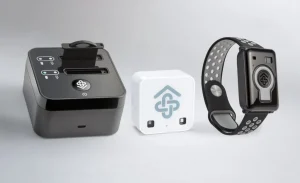If we’re already using contact lenses to track what’s happening inside the body, who’s to say that one day we won’t eventually use them to track what’s happening inside the brain?
While we almost always write articles like this about products that already exist, this time is an exception, and for good reason. If any of us were to try out a Brain Computer Interface, it would have to be non-invasive or no deal. While getting plugged into a virtual world is the stuff of dreams, if you didn’t cringe when the long spiky thing went into the back of Neo’s head in the first Matrix movie, you’re not human.
Now when companies talk about non-invasive BCIs, they usually mean systems like electromyography (EMG) sensors, EEG caps, or facial muscle tracking, all of which can detect signals without breaking the skin. But Neuralink? No, that’s fully surgical. If anything, they’re trying to make invasive BCIs feel more accessible, but they’re nowhere near non-invasive.
Windows to the Soul

In fact, if you read Neuralink’s Wikipedia page, it’s pretty much a horror show. Apart from all the backlash they’ve got for having to euthanize monkeys and pigs that they experimented on, they talk about a surgical robot that rapidly inserts probes into your brain. They also mention quite generously that this “may” not cause brain damage. Come on, which average person who wants to Deepdive is going to sign up for that?
The big issue, however, is that non-invasive BCIs have to read brain activity from a distance, which makes everything harder. Unlike Neuralink, which plants electrodes directly inside the brain, non-invasive methods have to pick up weak signals from outside the skull, and that’s like trying to hear a whisper from the other side of a wall.
Since the human skull is quite effective at blocking and distorting signals, EEG-based BCIs end up with a lot of noise and less precision compared to something directly implanted in the brain. That being said, however, we come to the reason we’re writing this article, there’s no skull between the eyes and the brain. Additionally, we communicate a massive amount of information through our eyes, mostly subconsciously yes, but we do it nonetheless.
There’s even an old saying about eyes being windows to the soul and people professionally trained to conduct interviews or even interrogations know this all too well. Everything from blink rate to pupil dilation, which direction your eyes move before you answer, and how you maintain eye contact speak loads about you as a person.
Smart lenses that read your mind

So, if our eyes are already broadcasting all this information, often without us even realizing it, why not tap into that? If we’re serious about non-invasive BCIs, then smart contact lenses might be the closest thing to a direct brain interface without needing surgery. Unlike EEG (Electroencephalography) caps that struggle to pick up faint neural signals through the skull, the eyes have direct neural connections to the brain via the optic nerve.
Additionally, scientists already use eye tracking to study cognitive load, attention shifts, and even subconscious decision-making, and there are a number of studies that prove that our thoughts leave traces in our gaze. If that’s true, isn’t it possible that the right tech could pick up on that?
Now though BCIs don’t exist in the form of contact lenses yet, smart lenses aren’t just some far-off sci-fi dream either. In fact, researchers are already developing ones that can monitor health conditions in real-time. Take glaucoma, for example. Researchers at Pohang University of Science and Technology (POSTECH) have developed a wireless theranostic smart contact lens capable of both monitoring IOP and delivering anti-glaucoma medication.
These lenses integrate intraocular pressure (IOP) sensors paired with a flexible drug delivery system that facilitate real-time monitoring as well as controlled drug release. Additionally, unlike traditional treatment for glaucoma that requires frequent eye exams, these lenses can continuously measure pressure changes throughout the day, sending alerts as soon as it detects that something seems off.
Fully wearable BCIs

And it’s not just glaucoma, scientists are working on lenses that could detect diabetes, measure hydration levels, and even monitor biomarkers in tears! We’ve all seen the spy movies with the magic glasses that keep feeding the protagonist loads of information about his surroundings. We call those things AR glasses now, and Ray-Ban makes them. There’s also a company called Lenstore that promised to make smart contact lenses that could record video and zoom up to 60X by 2021, though they haven’t been able to keep that promise, yet.
So if we already have magic spy glasses, and we’re already using contact lenses to track what’s happening inside the body, who’s to say that one day we won’t eventually use them to track what’s happening inside the brain? Like we already mentioned, people who are healthy and not suffering from paralysis or some other debilitating disease wouldn’t want to stick electrodes into their brains, and if the skull is the big problem here, the eyes seem like the only logical answer.
In case you missed:
- Lab-Grown Brain Thinks It’s a Butterfly: Proof We’re in a Simulation?
- Neuralink Blindsight and Gennaris Bionic eye, the future of ophthalmology?
- Samsung’s new Android XR Headset all set to crush Apple’s Vision Pro
- This computer uses human brain cells and runs on Dopamine!
- Scientists gave a mushroom robotic legs and the results may frighten you
- Could the Future of Communication Be Holographic?
- PVC Meta Coins: The Next Big Thing in Crypto?
- Mainstream AI workloads too resource-hungry? Try Hala Point, Intel’s largest Neuromorphic computer
- Having two left thumbs may no longer be a bad thing
- AI-powered smart devices for the hearing, vision, and speech-impaired









